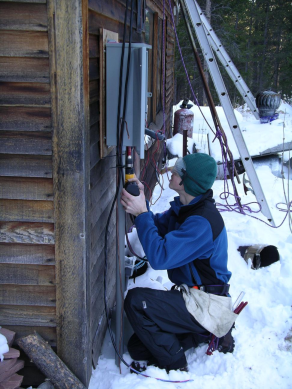For wiring photovoltaic panels together, you have a few options. The usual NEC compliant way is is to use liquid tight conduit and connectors, and run regular wire of the proper gauge. You can also use wire rather USE-2/RHW-2, which is rated for wet conditions and sunlight. This comes in single strands, and runs roughly $0.25/ft. You can also use Tray Cable, which commonly has multiple conductors in a bundle. This may be more convienient than having lots of single wires. These wires need moisture tight connectors. The 2 conductor Tray Cable needs oval connectors, and the 3 conductor Tray Cable is round. Because this cable is commonly used for AV wiring, it and the round connectors are the easiest to find. The 1/2 connectors fit the junction boxes on the photovoltaic panel's knockouts.

Long wire runs between the photovoltaic array and the charge controller can be a problem. Voltage drop shouldn't be above 3%, and when you are using an MMPT charge controller, 1.9% is recommended. Long runs of 12VDC are pretty much impossible. 24VDC is doable depending on the length, but 48 is the most likely. You can get charge controllers like RV Products of Outback's MX60 that will handle up to a 60VDC source. But big fat wires are difficult to run, especially in conduit. In these cases you can run parallel wires, as long as they are the same gauge and length.
Me personally, I'm tottally in love with cordless tools. Especially when you're working on the roof with ropes everywhere, it's nice to not have to screw around with an extension cord. My 18V tools have pretty good battery life. With two spare batteries I can get through most any day of projects. And they have a 12VDC charger, which is nice.
I've found the clamp style multimeters have problems in my power shed, because they seem to be over sensitive to being near the large battery bank. So a regular, and cheaper multimeter works just fine. Make sure to get one that does DC Amps if possible.
I have a power meter, there are several different ones available on the market. I use it to test devices before buying, as well as testing existing things I can't do without. While a power meter is most useful when planning a system for sizing purposes, it is also useful for evaluating what to buy when looking at AC appliances, like vacumns.